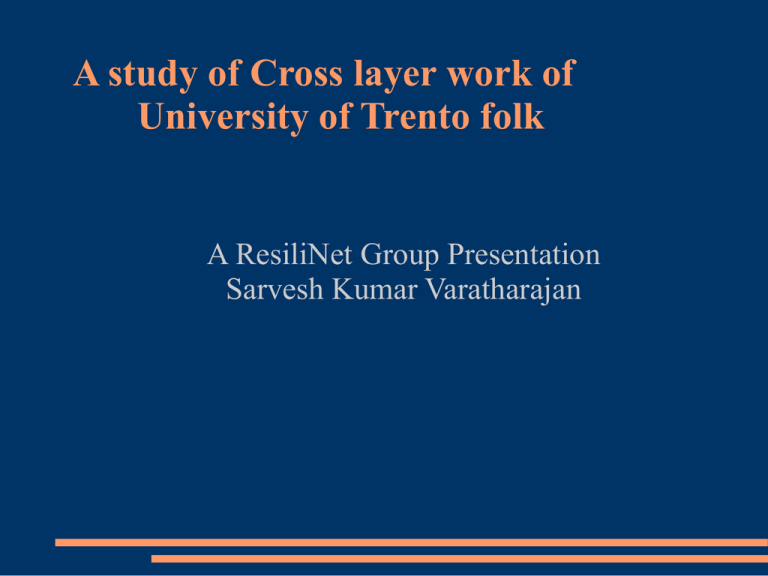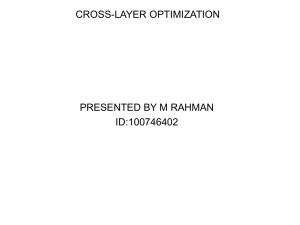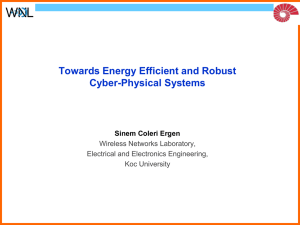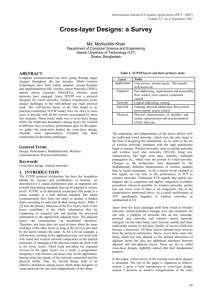Cross-layer Performance Optimization in wireless Local Area Network
advertisement

A study of Cross layer work of University of Trento folk A ResiliNet Group Presentation Sarvesh Kumar Varatharajan A study of Cross layer work of University of Trento folk Cross-Layer Performance Optimization in wireless Local Area Network (Kliazovich's PhD Thesis) Cross Layer ARQ ( Presented Today) Cross Layer Congestion Control (Present next week) The Cross-Layer Paradigm In Next Generation Internet: Open Issues & Future Perspectives( Granelli) (Walk through the foils) Formal Methods in Cross-Layer Modeling and Optimization of Wireless Networks: State of the Art and Future Directions (Skip!!!Difficult for me to understand :-( ) Cross-layer Performance Optimization in wireless Local Area Network Cross-Layer Performance Optimization in wireless Local Area Network (Kliazovich's PhD Thesis) Cross Layer ARQ Cross-layer Performance Optimization in wireless Local Area Network TCP/IP shows poor performance when extended to wireless network environment Limitations in terms of bandwidth,latency,channel loss and mobility Available Enhancement Schemes Link Layer Solutions Transport Layer Solutions Cross-Layer Solutions Cross-layer Performance Optimization in wireless Local Area Network Cross-layer Performance Optimization in wireless Local Area Network Link Layer Solutions TCP unaware link layer solution TCP unaware protocols optimize performance by hiding the differences between wired and wireless mediums Can cause adverse effects eg.) ARQ on TCP RTO TCP aware link layer solution Knowledge of transport layer protocol provides certain advantages eg.) Snoop Protocol Snoop Agents ( at the BS) caches the TCP packets that are sent to mobile nodes. Retransmissions occur locally Disadvantages Increases complexity at BS No consideration of packet loss delay during hand-off Cross-layer Performance Optimization in wireless Local Area Network Transport Layer Solutions Connection Splitting Solutions I-TCP (Indirect TCP) Split the connection into two One between FH and BS and the other between BS and MH Conceal the wireless link from the FH Disadvantages: End-to-end Schematics lost Additional overhead during hand-off Can't operate on encrypted packets TCP Modifications eg.) SACK Disadvantage: Modification of the ACK procedure both at sender and reciever Cross-layer Performance Optimization in wireless Local Area Network Cross-Layer Design ILC-TCP (Interlayer Collaboration Protocol) State Manager (SM) in parallel to protocol stack Each layer reports its state to the SM SM can signal TCP to stop sending packets if conditions not good Disadvantage: Additional Layer added to the sender Cross-layer Performance Optimization in wireless Local Area Network Analysis of existing schemes under 3 different scenarios Single-hop wireless connections Multi-hop wireless scenario Wireless-cum-wired scenario Conclusion from the related work No single best solution for all deployment scenario Cross-layer Performance Optimization in wireless Local Area Network TCP with link level ARQ Link layer is not the only layer which acknowledges packet delivery(TCP ACK's) “A single TCP data packet is acknowledged three times”( One time at the transport level and two times at the link level) This along with the fact that the physical layer preamble and header are transmitted at the lowest bit rate penalizes performance at higher bit rate Cross-layer Performance Optimization in wireless Local Area Network Optimization of the acknowledgement scheme through interaction between transport and link layer will bring down the medium busy time and will improve the performance A cross layer Link Layer ARQ Exploitation TCP (LLE-TCP) scheme proposed The idea is to generate the TCP ACK at the sender instead of sending it through the channel Cross-layer Performance Optimization in wireless Local Area Network Cross Layer ARQ Agent Operates between TCP and MAC Interfaces both LLE-TCP is a software module Goes into the firmware of the wireless card driver Cross-layer Performance Optimization in wireless Local Area Network Packet delivery diagram Cross-layer Performance Optimization in wireless Local Area Network Agent interaction with the Link Layer Success Failure Agent interaction with the transport layer Sender side ARQ Agent sniffs the packet generated by the higher layer Access the TCP headers On successful reception of the link layer ACK, it prepares the TCP ACK Upon SUCCESS TCP ACK is released to the Transport layer On FAILURE three duplicate ACK's are generated triggering the fast retransmit Cross-layer Performance Optimization in wireless Local Area Network Agent interaction with the transport layer Receiver side Silently drops all the standalone non-duplicate TCP ACK packets Advantages Does not interfere with the flow control mechanisms Reduces the Round Trip Time(RTT) Cross-layer Performance Optimization in wireless Local Area Network TCP Connection Phases Connection Establishment (Three Way handshake) Data Exchange Full ACK suppression Connection Termination ACK suppression is done only for the third handshake as sequence number synchronization,negotiation of the size of the contention window takes place Full ACK suppression Bidirectional data exchange If the incoming packet acknowledges a segment number lower or equal to the already acknowledged one,the ACK flag is cleared Cross-layer Performance Optimization in wireless Local Area Network Infrastructure Network Scenario TCP performs poorly in such environments due to completely different characteristics between fixed and wireless parts Cross-layer Performance Optimization in wireless Local Area Network TCP ACK's generated at the BS is delivered to the fixed host TCP ACK's avoided in the wireless part(bottleneck) LLE-TCP at BS accesses the rwnd of the ACK header and replaces it with empty buffer space left at the BS. Improves Congestion control Drawback: Complexity at the BS Mobile station switches off its LLE-TCP if the BS does not support it Cross-layer Performance Optimization in wireless Local Area Network Multi hop Networks Cross-layer Performance Optimization in wireless Local Area Network Congestion Control at the sender side LLE-TCP congestion control module (LLE-TCP_CC) LLE-TCP_CC buffer stores the packet till it gets the ACK from LHR rwnd set to 1 packet if LLE-TCP buffer not full rwnd set to 0 packets if LLE-TCP buffer is full Send a duplicate ACK for the last transmitted data packet with positive value for the advertised window Cross-layer Performance Optimization in wireless Local Area Network Experimental Results Simulation in ns-2 Implementation of single-hop scenario in 802.11b testbed( Fedora Core Linux with 802.11b Orinoco Silver Cards) TCP Reno is chosen for comparison Cross-layer Performance Optimization in wireless Local Area Network Single-hop Network (Simulation Results) Cross-layer Performance Optimization in wireless Local Area Network Single-hop Network ( Implementation Results) These results are 3% less than simulation results?? Cross-layer Performance Optimization in wireless Local Area Network Multi hop Scenario (Simulation Results) TCP Segment size=1000 bytes 10 % to 20 % improvement for small # of hops Cross-layer Performance Optimization in wireless Local Area Network Multi hop Scenario (Simulation Results) Three hops, static environment Cross-layer Performance Optimization in wireless Local Area Network Multi hop Scenario (Simulation Results) 30 nodes placed randomly in 100*100 m With node mobility ,AODV,RTS/CTS ON 1000s simulation Fewer route errors Fewer route discovery messages Reduced RTT Cross-layer Performance Optimization in wireless Local Area Network Infrastructure Network Scenario (Simulation Results) IEEE 802.11b Wired link 100Mbps,2ms Results close to single hop This is bec ACK is sent on wired link Congestion control at BS A study of Cross layer work of University of Trento folk Cross-Layer Performance Optimization in wireless Local Area Network (Kliazovich's PhD Thesis) Cross Layer ARQ ( Presented Today) Cross Layer Congestion Control (Present next week) The Cross-Layer Paradigm In Next Generation Internet: Open Issues & Future Perspectives( Granelli) (Walk through the foils) Formal Methods in Cross-Layer Modeling and Optimization of Wireless Networks: State of the Art and Future Directions (Skip!!!Difficult for me to understand :-( )








